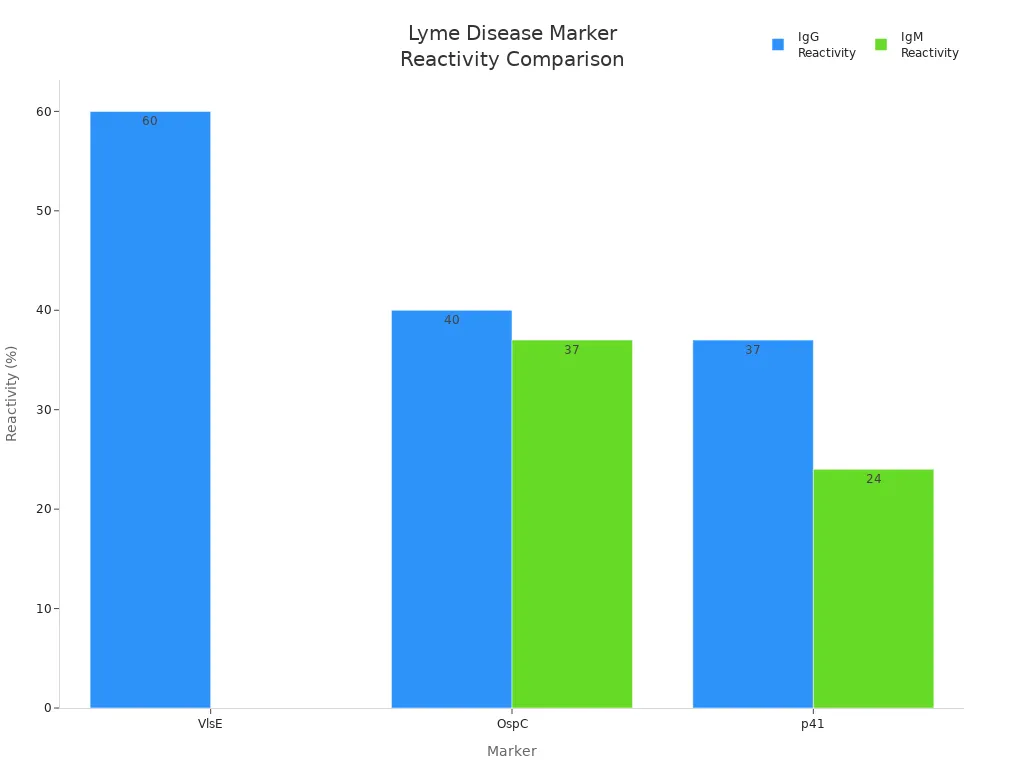News & Events
IgG P41 Ab: The Unsung Hero in Lyme Stories

You may wonder what the igg p41 ab means for Lyme disease. This antibody helps your immune system recognize the bacteria that cause Lyme. Doctors use antibody testing to look for signs your body has fought the infection. Understanding this marker gives you and caregivers better insight into your health journey.
Tip: Ask your healthcare provider about your antibody results. Clear answers help you make informed choices.
Key Takeaways
- IgG P41 Ab is an important antibody that helps your immune system recognize Lyme disease bacteria. Understanding this can empower you in your health journey.
- A positive IgG P41 Ab result does not confirm Lyme disease. Many healthy individuals can test positive, so always discuss your results with your doctor.
- Doctors use the Western blot test to detect IgG P41 Ab. This test is part of a larger process that includes looking for multiple bands to confirm a Lyme diagnosis.
- Persistent IgG P41 Ab antibodies can remain in your body for years, even after recovery. This does not necessarily indicate an ongoing infection.
- If you have symptoms but a negative test, consider retesting. Early Lyme disease may not show enough antibodies, so ongoing symptoms warrant further evaluation.
IgG P41 Ab Overview

What Is IgG P41 Ab?
You may see the term igg p41 ab on your Lyme disease test report. This antibody targets a protein called flagellin, which helps bacteria move. Your body makes igg p41 ab when it tries to fight off the bacteria that cause Lyme disease. Scientists first noticed this antibody because it appears early in many infections. Over time, experts learned that it is one of several markers used in Lyme testing.
Note: The p41 band gets its name from the size of the flagellin protein, which is about 41 kilodaltons.
Here is a table showing how researchers developed the use of igg p41 ab in Lyme testing:
| Study | Key Findings | Impact on IgG P41 Ab Development |
|---|---|---|
| Dressler et al. | Evaluated optimal WB banding patterns for IgM and IgG antibodies. | Established criteria for IgG reactivity to at least 5 of 10 antigens, leading to high diagnostic accuracy for Lyme disease. |
| Engstrom et al. | Monitored antibody expansion in patients over a year. | Improved sensitivity for early and late Lyme disease through IgG seroreactivity at two of five bands. |
Role in the Immune Response
Your immune system uses antibodies to find and attack germs. When you get Lyme disease, your body starts making igg p41 ab to target the bacteria’s flagellin. This antibody acts like a signal, telling your immune cells where to focus their attack. You may notice that your test shows several bands. Each band stands for a different antibody your body makes against Lyme bacteria.
- IgG antibodies help your body remember past infections.
- The p41 antibody shows your immune system has reacted to something similar to Lyme bacteria.
Relevance to Lyme Disease
You might think a positive igg p41 ab result means you have Lyme disease. This is not always true. Many healthy people test positive for this band. Some labs report faint bands as positive, which can confuse you. Your immune system can keep making these antibodies long after the infection is gone.
Here is a table that clears up common misconceptions:
| Misconception | Explanation |
|---|---|
| Misinterpreting fewer than 5 bands on the IgG Western blot as positive | Many people without Lyme disease will test positive for some bands, especially band 41, which is commonly positive in healthy people. |
| Interpreting faint (but negative) Western blot bands as positive | Some predatory labs return results that allow people to misinterpret indeterminate (IND) or faint bands as positive. |
| Misinterpreting persistent antibodies as persistent infection | Our immune systems have memories such that antibodies can be detected many years after infection. |
Tip: Always ask your doctor to explain your full test results. Do not rely on just one band.
IgG P41 Ab Testing

Western Blot Method
You may wonder how doctors find the igg p41 ab in your blood. The Western blot test is the main method they use. This test looks for antibodies your body makes against Lyme bacteria. First, your blood sample gets mixed with proteins from the Lyme bacteria. If your immune system has made antibodies, they stick to these proteins. The test then shows bands, each representing a different antibody.
The p41 band stands for the flagellin protein. This protein helps the Lyme bacteria move. When you see the p41 band on your test, it means your body has made antibodies against flagellin. Doctors use Western blot after an initial screening test, like ELISA or IFA. This two-step process helps confirm if you have Lyme disease.
Here is a table that shows how labs use Western blot for Lyme testing:
| Aspect | Details |
|---|---|
| Methodology | Line blot |
| Result Turnaround Time | 1 – 5 days |
| Test Includes | Line blot analysis for IgG- and IgM-specific antibodies |
| Use | Second step after ELISA or IFA to confirm infection with B burgdorferi |
| Special Instructions | Should follow an initial positive or equivocal ELISA/IFA test |
| Additional Information | Provides both IgM and IgG results; increased specificity reduces cross-reactivity |
Note: The Western blot test helps confirm Lyme disease, but it does not work alone. Doctors look at your symptoms and other test results too.
Interpreting the p41 Band
When you get your test results, you may see the p41 band listed. This band shows your body has made antibodies to flagellin. Many healthy people also have a positive p41 band. This means the p41 band alone does not prove you have Lyme disease. Doctors look for several bands together before making a diagnosis.
The p41 band can show up in both IgM and IgG tests. IgM antibodies appear early after infection and usually fade after a few weeks. IgG antibodies, like igg p41 ab, stay longer and show your immune system remembers the bacteria. The Centers for Disease Control and Prevention (CDC) say you need at least five IgG bands for a positive Lyme diagnosis.
Here is a table to help you understand what the p41 band means:
| Evidence Point | Description |
|---|---|
| Presence of p41 Band | The 41 KD (IgM) band often appears in Western blot tests but is not enough for diagnosis. |
| Positive Results in Healthy Individuals | Many healthy people test positive for the 41 KD band, so it does not confirm Lyme disease. |
| IgM Antibody Significance | The 41 KD band links to IgM antibodies, which show recent infection and fade after eight weeks. |
Tip: Ask your doctor to explain all your bands, not just p41. A single band does not tell the whole story.
Test Limitations
You may think a positive igg p41 ab result means you have Lyme disease. This is not always true. The p41 band can react with antibodies from other bacteria, not just Lyme. This is called cross-reactivity. Labs now use more specific proteins, like VlsE and OspC, to improve accuracy.
Here are some important points about test limitations:
- The IgG Western blot test finds antibodies against Borrelia burgdorferi, but it works best as a confirmatory test after a screening test.
- Modern tests include proteins that are less likely to cross-react with other infections, making results more reliable.
- Early Lyme disease may not show enough antibodies, so you could get a false-negative result.
- Doctors may repeat tests or use newer methods if your symptoms continue.
Doctors use several bands, not just p41, to make sure the diagnosis is correct. The CDC requires at least five IgG bands for a positive result. This helps avoid mistakes from cross-reactivity or faint bands.
Alert: If you get a positive p41 band but do not have other Lyme symptoms or bands, you may not have Lyme disease. Always talk to your doctor about your full results.
Result Interpretation
Positive vs. Negative Results
When you look at your Lyme disease test report, you may see results for igg p41 ab. A positive result means your body has made antibodies to the flagellin protein found in Lyme bacteria. This shows your immune system has responded to something similar to Lyme. However, doctors do not rely on just one band. They look for several bands together to confirm Lyme disease.
A negative result can feel confusing, especially if you have symptoms. You should know that a negative igg p41 ab result does not always mean you do not have Lyme disease. Sometimes, your body has not made enough antibodies yet, especially in the early stages of infection. If you have symptoms or a history of tick exposure, your doctor may suggest retesting or getting a second opinion.
Note: Always share your symptoms and exposure history with your doctor. This helps them interpret your test results more accurately.
Here is a quick guide to help you understand negative results:
- A negative result does not rule out Lyme disease if you have symptoms or tick exposure.
- Early infection may not show enough antibodies, leading to a negative test.
- Ongoing symptoms after a negative test may mean you need retesting.
False Positives/Negatives
Lyme disease testing can sometimes give false results. You may see a positive igg p41 ab band even if you do not have Lyme disease. This happens because the p41 band can react with antibodies from other bacteria. Doctors call this cross-reactivity. On the other hand, you may get a negative result even if you have Lyme disease, especially in the early stages.
The following tables show how often false results happen:
| Test Type | False Positive Rate | Source Link |
|---|---|---|
| IgG P41 Ab Testing | 27.5% | Appropriate laboratory testing in Lyme disease |
| Test Type | False Negative Rate | Source Link |
|---|---|---|
| IGeneX IgG WB | 32% | I was just diagnosed with Lyme disease |
You should know that cross-reactivity makes Lyme testing tricky. Sometimes, people with Lyme-like symptoms test positive for p41 antibodies because of other spirochetes. This can lead to misdiagnosis. Doctors use more specific markers and look for several bands to reduce mistakes.
Alert: If your test result does not match your symptoms, talk to your doctor about retesting or other tests.
IgG P41 Ab in Lyme Diagnosis
Doctors use igg p41 ab as part of a bigger picture. The p41 flagellin antigen helps show your immune system has reacted to Lyme bacteria. However, modern testing uses several markers to make the diagnosis more accurate. You need more than just a positive p41 band.
Here is how doctors confirm Lyme disease:
- The p41 antibody is useful in early Lyme disease, but doctors combine it with other antigens for a full evaluation.
- A positive Lyme immunoblot test requires antibodies against at least two proteins for IgM or five proteins for IgG from Borrelia burgdorferi.
- Doctors look for multiple bands to improve diagnostic precision.
After treatment, antibody levels can change. Some people see their antibody levels drop within months. Others may have elevated antibodies for years, even if they feel better. This persistence does not always mean you still have Lyme disease.
- Cross-reactivity can cause antibodies to stay high after treatment.
- Some studies show antibody levels decrease 4–6 months after treatment.
- Other studies found that elevated antibody levels can last for years, no matter how you feel.
Tip: Ask your doctor to explain how your antibody levels fit with your symptoms and treatment history.
Clinical Significance
Diagnostic Value
You may wonder how doctors use igg p41 ab when diagnosing Lyme disease. This antibody is one of several markers that help show if your body has fought the Lyme bacteria. Doctors look for patterns in your test results. They do not rely on just one band. Instead, they check for a combination of bands to make a diagnosis.
Here is a table that shows the criteria for a positive Lyme test:
| Marker Type | Criteria for Positivity | Peptide Bands Present |
|---|---|---|
| IgG | 5 of 10 bands | p18, p23, p28, p30, p39, p41, p45, p58, p66, p93 |
| IgM | 2 of 3 bands | p23, p39, p41 |
Recent research found that combining a positive IgG band 41 with a higher CD4/CD8 ratio can improve the accuracy of Lyme diagnosis. This approach helps doctors make better decisions for your care.
Impact on Treatment
Doctors use your antibody results to guide treatment, but they do not base decisions on igg p41 ab alone. You may see a positive p41 band, but this does not always mean you need antibiotics. Many healthy people test positive for this band.
A study examined the banding patterns of patients with chronic Lyme disease and healthy controls, revealing that a significant number of healthy individuals tested positive for the 41kd band. This suggests that the presence of IgG P41 Ab is not a reliable indicator of Lyme disease exposure.
Your doctor will look at your symptoms, history, and other test results before starting treatment. If you have symptoms and several positive bands, your doctor may recommend antibiotics. If you only have a positive p41 band and no symptoms, your doctor may suggest watchful waiting.
Comparison to Other Markers
Not all Lyme markers work the same way. Some are more specific than others. VlsE and OspC are two markers that help doctors tell Lyme disease apart from other illnesses. These markers show up less often in healthy people.
| Marker | IgG Reactivity in PSL Group | IgM Reactivity in PSL Group | Specificity |
|---|---|---|---|
| VlsE | 60% | N/A | High |
| OspC | 40% | 37% | High |
| p41 | 37% | 24% | Low |

- VlsE often shows the highest IgG reactivity and has high specificity.
- OspC helps detect early Lyme infection and is also specific.
- p41 appears in both Lyme patients and healthy people, so it is less specific.
If your test shows only the p41 band, you should talk to your doctor. You may need more tests or a follow-up visit to get a clear answer.
You may feel confused when you see IgG P41 Ab results on your Lyme disease test. These results do not always show if your infection is new or old. Sometimes, people with Lyme disease do not have enough antibodies for a clear answer. You should talk to your healthcare provider for help.
| Organization | Recommendation |
|---|---|
| AAN/ACR/IDSA | Ask a clinical laboratory director with Lyme experience. |
| Lyme Testing Guide | Discuss your results and symptoms with your doctor. |
- Remember, the 41 KD band alone does not confirm Lyme disease.
- Check if you have symptoms before worrying about your test.
- Ask your doctor about next steps if you have questions.
Your doctor can help you understand your results and plan what to do next.
FAQ
What does a positive IgG P41 Ab result mean?
A positive IgG P41 Ab result shows your immune system has made antibodies to the flagellin protein. You should know this does not confirm Lyme disease by itself. Doctors look for several bands before making a diagnosis.
Tip: Ask your doctor to explain all your test bands.
Can healthy people have a positive p41 band?
Yes, many healthy people show a positive p41 band. This band reacts to other bacteria, not just Lyme. You should not worry if you see only this band on your test.
| Group | Positive p41 Band (%) |
|---|---|
| Healthy People | Up to 37% |
| Lyme Patients | Higher |
How long do IgG P41 Ab antibodies stay in your body?
IgG P41 Ab antibodies can stay in your body for years. Your immune system remembers past infections. You may see these antibodies long after you recover.
Note: Persistent antibodies do not always mean you still have Lyme disease.
Should you get retested if your symptoms continue?
You should get retested if symptoms continue and your first test was negative. Early Lyme disease may not show enough antibodies. Doctors may use other tests or repeat the Western blot.
- Retesting helps confirm diagnosis.
- Doctors use your symptoms and history to guide testing.
Is the p41 band enough for Lyme treatment?
No, the p41 band alone is not enough for Lyme treatment. Doctors need more evidence, like multiple positive bands and symptoms. You should follow your doctor’s advice before starting any treatment.
Alert: Never start antibiotics based only on one band.

